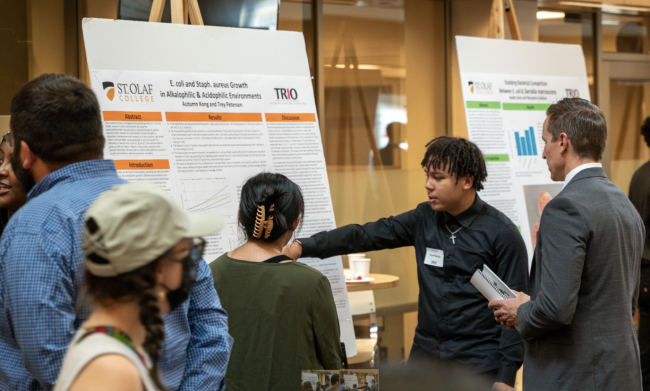You have /5 articles left.
Sign up for a free account or log in.

Students in St. Olaf College’s summer bridge program take a lab-based science course and a writing class. Program alumni have retention and graduation rates comparable to the college’s as a whole. Here, two students share their research findings with Brian Greening, right, the college’s director for TRIO Student Support Services.
St. Olaf College
College wasn’t really on Jordy Malmaceda’s radar when he was in high school. That’s until a representative from Salt Lake Community College visiting his school talked to him about SLCC’s free summer bridge—an eight-week program for first-generation, underrepresented graduating seniors. The SLCC representative told Malmaceda he’d not only earn college credit and a small stipend by attending summer bridge but also qualify for a college scholarship, should he wish to attend that fall.
Malmaceda, who would be the first in his family to go to college, says he recognized summer bridge as an opportunity. So he took it. He spent the summer of 2021 completing a writing-intensive English course and a separate study skills class, as well as workshops on math and life skills including financial literacy.
The study skills course was especially helpful, he recalls.
“It talked a lot about time management and taking notes and really prepared me.” One lasting message from the class? “Due dates are important.”
Malmaceda also spent time bonding with other summer bridge students during planned weekly social events. His favorite? An outing to a local high-ropes course, which struck that time-tested balance of being “scary, but at the same time very fun.”
Today, Malmaceda is a marketing management major at SLCC who plans to graduate in 2024. He still keeps in touch with some of his summer bridge friends and even works in that office as a program associate.
“Summer bridge is definitely something I would recommend,” he says, even it meant effectively forgoing summer vacation after high school. “It’s just a small sacrifice, but it’s a really good opportunity.”
Summer Bridge Benefits
Whether students are reluctant about college or not, research suggests that summer bridge programs offer participants some lasting benefits. And in the recent Student Voice survey from Inside Higher Ed and College Pulse, alumni of specialized summer bridge and extended orientation programs rated their orientation experiences more highly and reported better orientation outcomes than both first-generation and continuing-generation college peers who did not participate in summer bridge.
The Student Voice survey, circulated this summer, asked 3,000 two- and four-year college students and recent graduates about new-student orientation and other aspects of their college experience. Respondents over all tend to rate their orientations highly, with 73 percent saying theirs was good or excellent. Yet the 98 respondents who said they completed a specialized summer bridge or extended orientation experience rate their orientation especially highly: 86 percent say it was good or excellent.
Summer bridge programs typically run from two to eight weeks and invite first-generation, low-income or otherwise underrepresented students to an extended introduction to college life. At residential colleges, summer bridge usually involves living on campus in dorms and taking up to two classes together as a cohort. Building bonds with peers through structured social activities is also stressed, as is exposure to student support services. Bridge programs at community colleges, like Malmaceda’s, are similarly intensive but lack the residential component.
First-gen and continuing-gen student respondents to the Student Voice survey generally agree on what orientation should cover or include. About half of each group identifies the following seven areas of 13 possible options as priorities:
- Information about academic support, such as tutoring and the writing center
- Social events to meet other students
- Information about academic expectations
- Mental health awareness
- Community-building efforts, such as meeting other students in residence halls or connecting with students in one’s degree program
- Opportunities to connect with and ask questions of current students
- Information about extracurricular opportunities
A third of first-gen and continuing-gen students alike also say it’s important to include specialized programs and events for first-gen students. About the same share of students say orientations should include specialized programs and events for students of color, and this is consistent across major racial groups.
Students’ orientation outcomes differ by their experience type, however, especially with respect to feelings of academic preparedness and social connection. For example, 58 percent of summer bridge alums (n=98) say that orientation (including summer bridge) made them feel more comfortable accessing resources for students. That’s compared to 44 percent of first-gen students who did not complete summer bridge (n=1,057) and 43 percent of continuing-gen students with no summer bridge (n=1,648).
Similarly, some 56 percent of summer bridge alums say their introduction to college helped them feel more prepared, compared to 39 percent of first-gen students who didn’t do a summer bridge and 40 percent of continuing-gen students.
Socially, half of summer bridge alums say orientation helped them make friends, versus about a quarter each of the first-gen no-summer-bridge group and continuing-gen groups. In fact, relatively more first-gen no-summer-bridge students strongly agree that orientation did not help them make friends (28 percent). Same for the continuing-gen group (31 percent report that they made no friends at orientation).
Relatively more summer bridge alums also agree that their orientation experiences connected them with crucial student supports. Forty-four percent of the summer bridge group say that orientation familiarized them with mental health resources, compared to about a quarter of their non-summer-bridge peers (both first and continuing gen). Results were similar for whether orientation “connected me with campus staff [I] could turn to for help.”
Summer bridge seems to offer no advantage in helping students register for classes. Yet as summer bridge participants also usually complete their institutions’ main orientation programs, they’re not at a disadvantage in this respect.
‘Gateway to Success’
Brian W. Greening, director of student support services at St. Olaf College in Minnesota, where summer bridge is affiliated with the federal TRIO programs for opportunity outreach, tells his summer bridge students and their families that “bridges are hate-me-now, love-me-later situations.” The college’s 40 summer bridge participants, drawn from the general applicant pool, give up their last month of summer before matriculating to take two credited courses—one in writing and one lab-based science class—to “be really stressed out,” he adds.
Yet just a few weeks into the fall semester, Greening continues, the summer bridge alum feedback shifts to something like, “I get it. I appreciate it now.”
Nationally, first-gen students face significant barriers to college completion relative to their continuing-gen peers. According to one Pew analysis, for instance, 20 percent of adults aged 22 to 59 whose parents have no college education have a bachelor’s degree. Among adults with a parent who completed some college, 34 percent have a bachelor’s. Meanwhile, among adults with one parent with a bachelor’s degree, 60 percent have completed college. For adults with two parents with bachelor’s degrees, it’s 82 percent.
At St. Olaf, the most recent five-year average retention rate for summer bridge alums was 92 percent—slightly higher than the rate for the college as a whole. During the same five years, bridge alums' six-year graduation rates averaged 76 percent.
“In providing this robust onboarding experience for our low-income, first-gen students, during which they acclimate to the rigor and pace of college courses, get familiar with the footprint of the college, connect with resource hubs, and otherwise unveil hidden curriculum stuff, we see bridge as a gateway for success for our students.”
Joanna Perez, a St. Olaf senior majoring in vocal performance and minoring in Latin American studies, completed a virtual summer bridge experience in 2020 and worked with summer bridge students in 2021 and again this year. Perez met her roommate of two (going on three) years during summer bridge and emphasizes the program’s social, academic and even professional benefits.
“I’ve gotten to make a lot of new connections through not only the summer bridge program but also the associated links that it has to the campus community and the college as a whole,” she says.
Perez, who’s worked with first-gen, low-income and racially underrepresented students as a writing tutor and through the Piper Center for Vocation and Careers on campus, says she’s “really thrived because of the stepping-stones that I had in summer bridge.”
Tell us about a specific aspect of a summer bridge program at your institution that you believe is innovative.





